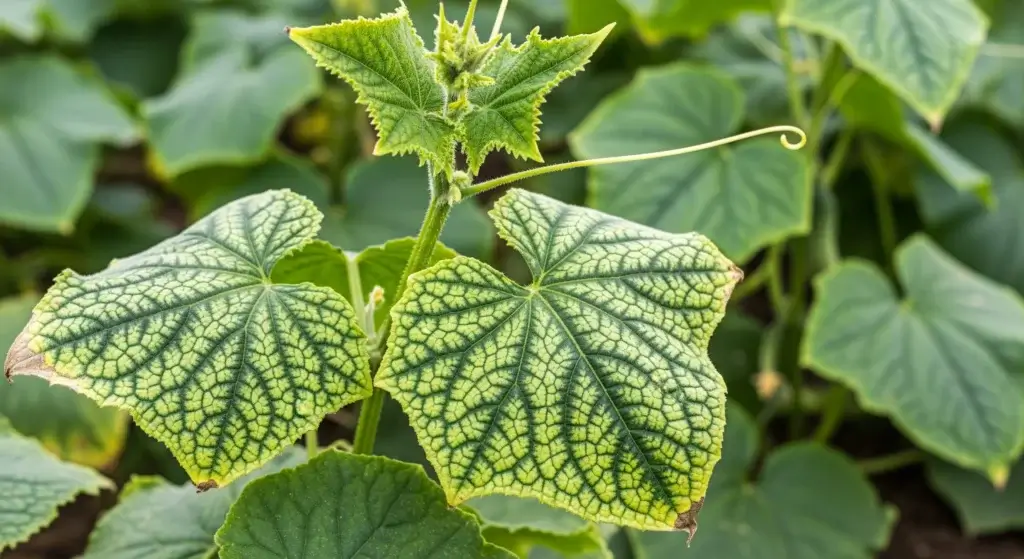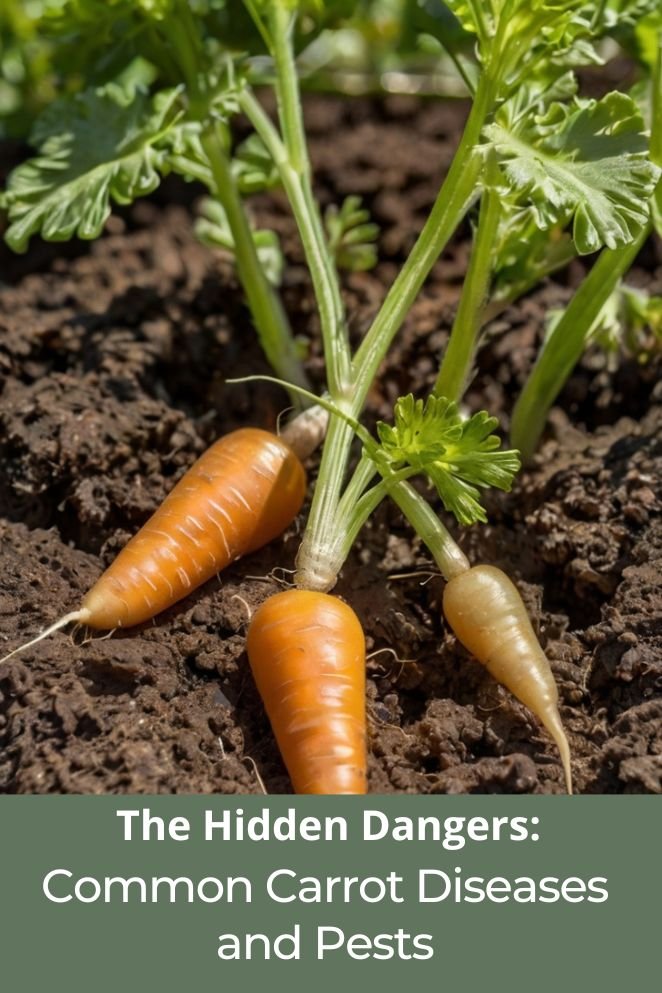
Carrots are a popular garden crop, known for their crisp texture and nutritional value.
However, they are not immune to a variety of diseases and pests, which can affect their growth, yield, and quality.
Whether you’re a home gardener or a commercial farmer, understanding the most common carrot diseases and pests, and how to prevent and control them, is key to successful cultivation.
In this article, we’ll cover the most common diseases and pests that affect carrots, effective prevention strategies, and control methods to help you keep your carrot crop healthy.
Common Carrot Diseases
Carrot diseases can stem from various fungi, bacteria, and environmental factors.
Here are the most common ones to watch for:
Aster yellows
Aster Yellows is caused by a type of organism called a phytoplasma, which acts like bacteria and is spread by tiny insects known as leafhoppers.
When carrots get infected, they show signs like yellowed, twisted leaves, and their growth becomes stunted.
The roots can turn out misshapen, taste bitter, and may even develop extra “hairy” roots or discoloration.
Prevention tip: The best way to prevent this disease is to control leafhopper populations and remove any infected plants right away to stop the spread.
- Read also: The Ultimate Foe: Common Potato Pests and How to Defeat Them
- Read also: Garden Detectives: Cracking The Signs of Pest in Vegetables
Black root rot
Black Root Rot is a fungal disease caused by the fungus Thielaviopsis basicola.
It usually affects carrots grown in cool, damp soils.
The first sign is dark spots or lesions on the roots, which then spread and merge, eventually turning the entire root black.
This severely affects the quality of the carrots, making them unfit to eat.
Prevention tip: Make sure you plant carrots in well-drained soil and rotate crops regularly to reduce the presence of this harmful fungus in the soil.
Cavity spot
Cavity Spot is another disease caused by pathogens in the soil, particularly by species of Pythium.
It results in small, sunken, discolored spots on the surface of the carrot roots.
Over time, these spots can grow larger, ruining the appearance and marketability of the carrots.
Prevention tip: To prevent cavity spot, maintain good soil drainage and ensure the overall health of your soil.
Common scab
Common Scab is caused by a bacteria-like organism called Streptomyces scabies. It creates rough, cork-like patches on the carrot’s surface, making them look unappealing.
However, the carrots are still safe to eat.
This disease tends to thrive in dry, alkaline (high pH) soils.
Prevention tip: Keep the soil slightly moist and maintain a soil pH between 5.5 and 6.5 to lower the chances of scab developing.
Leaf blight (alternaria dauci)
Leaf blight is a fungal disease caused by Alternaria dauci.
It starts off as small brown or black spots on the carrot leaves.
Over time, these spots grow bigger and can cause the leaves to wither and die.
When this happens, it reduces the plant’s ability to grow, leading to a smaller harvest and lower-quality carrots.
Prevention tip: To avoid leaf blight, try to avoid watering your plants from above, as wet leaves encourage fungus. It’s also helpful to choose carrot varieties that are resistant to this disease.
Cercospora leaf spot
Cercospora leaf spot, caused by the fungus Cercospora carotae, shows up as small, circular spots on the carrot leaves.
These spots slowly grow and can join together, leading to less photosynthesis (the process by which plants make food), which weakens the plant and affects growth.
Prevention tip: To reduce the risk of this disease, make sure you space your plants well to allow good air circulation, and rotate your crops to keep the soil healthy and less prone to infections.
Cottony rot (Sclerotinia Rot)
Cottony rot is caused by the fungus Sclerotinia sclerotiorum.
This disease results in a white, cotton-like fungal growth that appears on the carrot roots and leaves.
It’s most common in cool, damp conditions and can lead to rotting carrots, which makes them unusable.
Prevention tip: To prevent cottony rot, ensure your plants get plenty of airflow and avoid overwatering. Keeping the environment dry helps reduce the likelihood of this fungus taking hold.
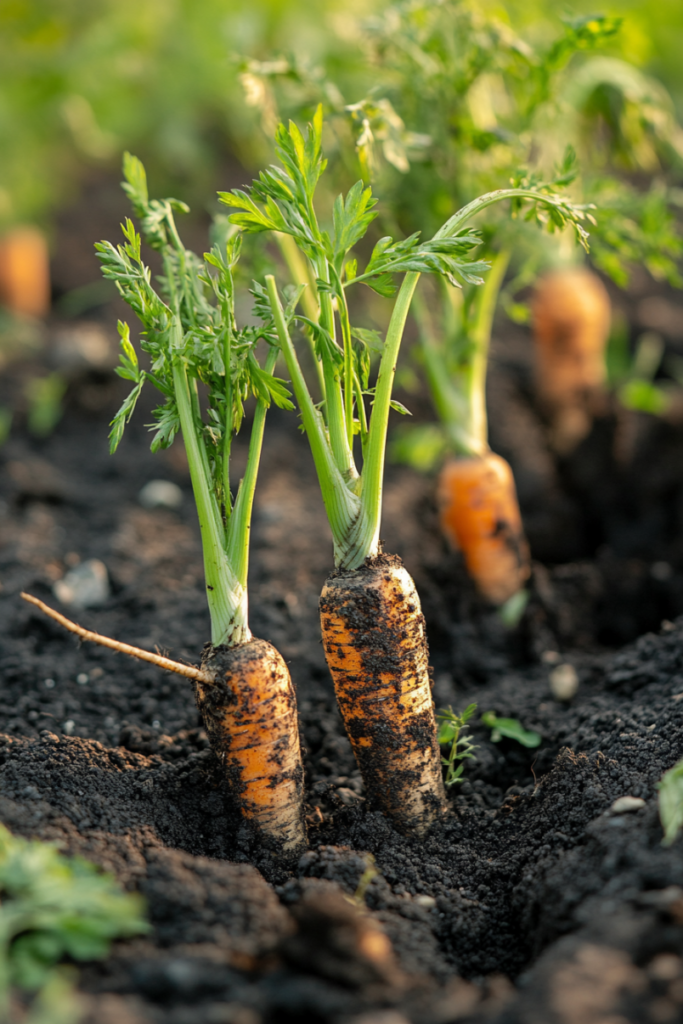
Common Carrot Pests
Carrots are vulnerable to several pests that can damage roots, leaves, and overall plant health.
Here are the most common pests to monitor:
Carrot fly
The carrot fly (Psila rosae) is one of the most destructive pests for carrots.
Its larvae feed on the carrot roots, creating tunnels and leaving behind dark brown streaks.
This damage can lead to stunted growth, increased risk of secondary infections, and a lower overall yield.
Adult carrot flies are especially attracted to the smell of crushed or damaged carrot leaves, making it easy for them to find their way to your crop.
Prevention tip: To keep carrot flies at bay, use row covers to physically block adult flies from laying their eggs near your plants. Also, avoid thinning carrots on windy days because the scent of broken leaves can attract flies from far away.
Wireworms
Wireworms are the larvae of click beetles and can cause serious damage by burrowing into carrot roots.
They create small holes throughout the root, often making the carrots unsuitable for eating.
These pests are particularly tricky because they live in the soil, where they can attack your carrots unnoticed.
Prevention tip: To avoid wireworm infestations, don’t plant carrots in areas where wireworms have been a problem before. Crop rotation can also help break the lifecycle of wireworms, making it harder for them to thrive.
Aphids
Aphids are tiny, sap-sucking insects that can colonize carrot plants, weakening them by draining their nutrients.
Aphids are not only a direct threat to plant health, but they also spread diseases like aster yellows, which can cause even more damage.
Prevention tip: To control aphid populations, encourage natural predators like ladybugs, which feed on aphids. If the problem persists, you can also use insecticidal soaps, which are a safer, plant-friendly way to manage aphids.
Slugs and snails
Slugs and snails are common garden pests that particularly love feeding on young carrot plants.
They leave large, irregular holes in the leaves and can even damage the roots, making it harder for your carrots to grow properly.
Prevention tip: Handpick slugs and snails from your garden in the evening when they are most active. You can also create barriers using materials like crushed eggshells, which are uncomfortable for slugs and snails to crawl over, helping to keep them away from your plants.
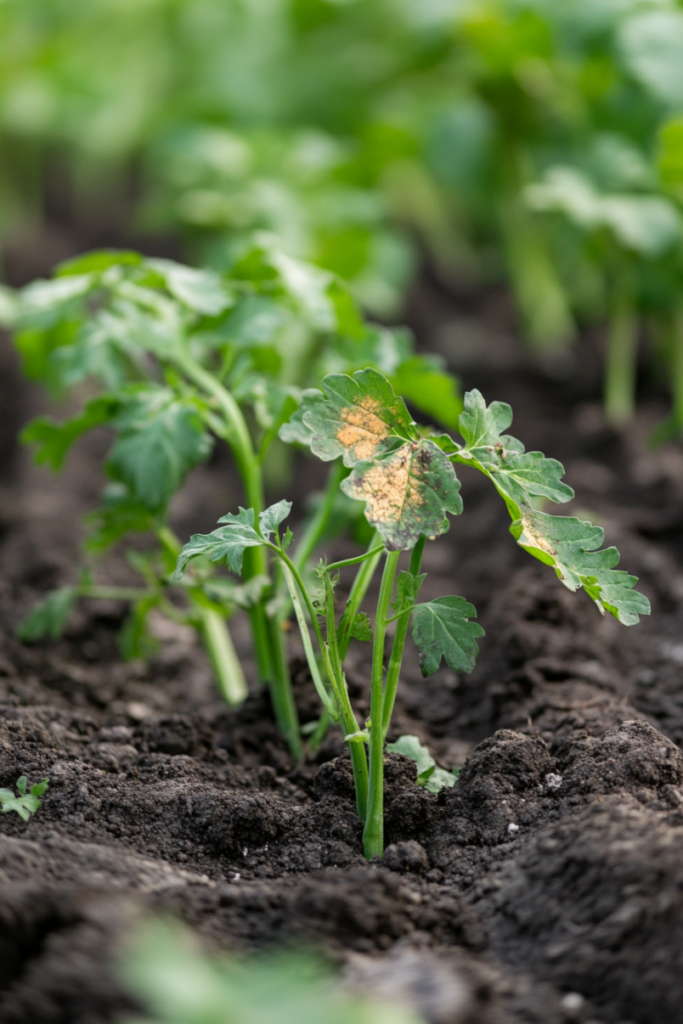
Prevention Strategies
When it comes to growing healthy, pest- and disease-free carrots, prevention is key.
By taking some simple steps ahead of time, you can avoid a lot of common problems.
Here are some effective strategies to help keep your carrot crops thriving:
Crop rotation
One of the best ways to prevent diseases and pests from becoming a big problem is to practice crop rotation.
This means not planting carrots (or other root vegetables) in the same spot year after year.
Pests and diseases can build up in the soil if you keep planting the same crops in one area, so rotating your crops helps break this cycle.
Maintain healthy soil
Healthy soil is your best defense against pests and diseases.
To keep your soil in good shape, add organic matter like compost to improve drainage and promote the growth of beneficial microbes.
These helpful microbes can outcompete harmful pathogens and make it harder for diseases to take hold.
Use disease-resistant carrot varieties
When possible, choose disease-resistant carrot varieties.
Some carrots have been specifically bred to resist diseases like leaf blight or cavity spot.
Planting these varieties reduces the need for chemical treatments and makes it easier to grow healthy carrots.
Proper planting and spacing
Giving your carrots enough space when planting is crucial.
If you plant them too close together, it can lead to poor air circulation, which makes it easier for diseases like fungal infections to spread.
Make sure to plant carrots at the correct depth and give them enough room to grow freely without overcrowding.
Watering and fertilization
Carrots need consistent watering, but it’s important not to overdo it.
Water stress—either too much or too little water—can weaken your plants and make them more vulnerable to disease.
Keep the soil evenly moist, but avoid overwatering, which can encourage fungal problems.
A steady balance of water and nutrients will keep your plants strong and healthy.
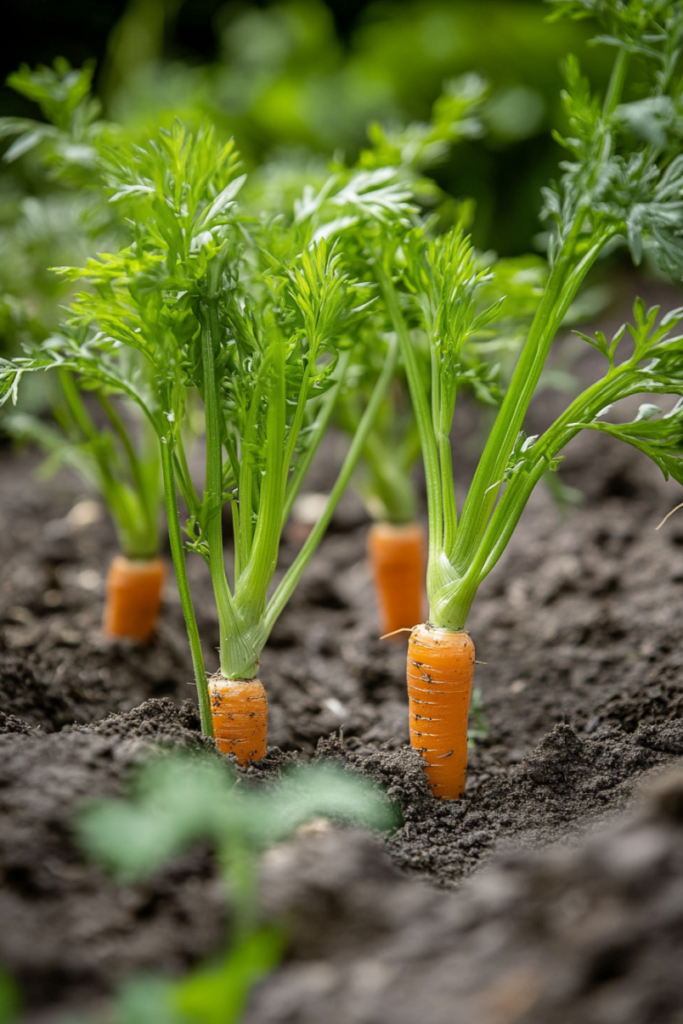
Control Methods
Even with the best prevention, pests and diseases can sometimes still make their way into your garden.
Here are some practical ways to control them and protect your carrots:
Cultural practices
Using good cultural practices can make a big difference in managing pests and diseases.
Simple tasks like regular weeding help reduce competition for water and nutrients while also getting rid of places where pests might hide.
Mulching around your carrots can also help by keeping the soil at a stable temperature and retaining moisture, which reduces stress on the plants and makes them less vulnerable to disease.
Biological control agents
Nature has its own pest control system, and you can use it to your advantage.
Beneficial insects like ladybugs, lacewings, and parasitic wasps are great allies in controlling pest populations naturally.
They feed on harmful insects like aphids, keeping their numbers down.
In addition, certain beneficial fungi like Beauveria bassiana can help fight soil pests such as wireworms.
Using these natural methods is safer for your garden and the environment.
Chemical control (when necessary)
Sometimes, despite your best efforts, you may need to turn to chemical control.
This should be your last resort, especially if you’re aiming for a more organic approach.
If you do decide to use pesticides or fungicides, it’s important to carefully read and follow the instructions on the label.
Always target the specific pest or disease affecting your carrots and avoid overuse, as chemicals can harm beneficial insects and lead to other unintended consequences.
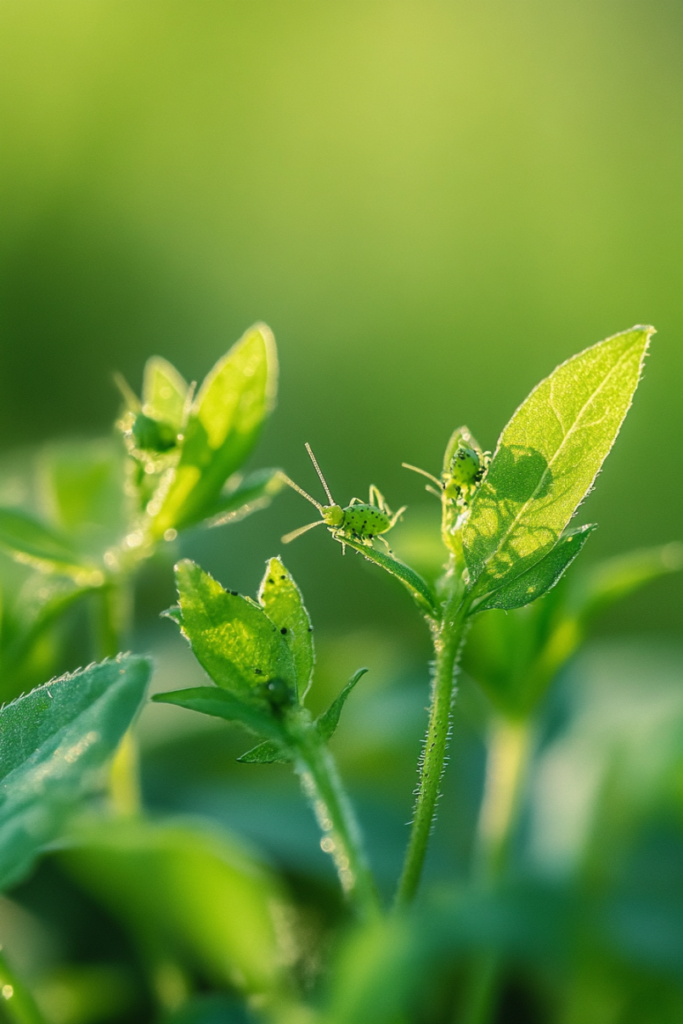
- Read also: Stress-Free Gardening: Top Tips to Protect Vegetables From Pests
- Read also: The Pesticide Paradox: The Impact of Pesticides on Vegetable
Final Thoughts
Growing carrots successfully requires a proactive approach to managing diseases and pests.
By combining preventive strategies, such as crop rotation and proper planting, with effective control methods, you can protect your carrot crop from common threats.
Healthy soil and a well-maintained garden can go a long way in preventing many of the diseases and pests outlined above, allowing you to enjoy a bountiful harvest.
FAQs
Symptoms like discolored leaves, stunted growth, root lesions, or unusual root shapes can indicate disease. Always inspect your plants regularly for early signs of trouble.
Using row covers to physically block carrot flies from laying eggs on your plants is one of the most effective prevention strategies.
Carrots with minor pest damage, such as small tunnels from wireworms, can be eaten if the damaged parts are cut away. However, severe infestations may render the crop unusable.

